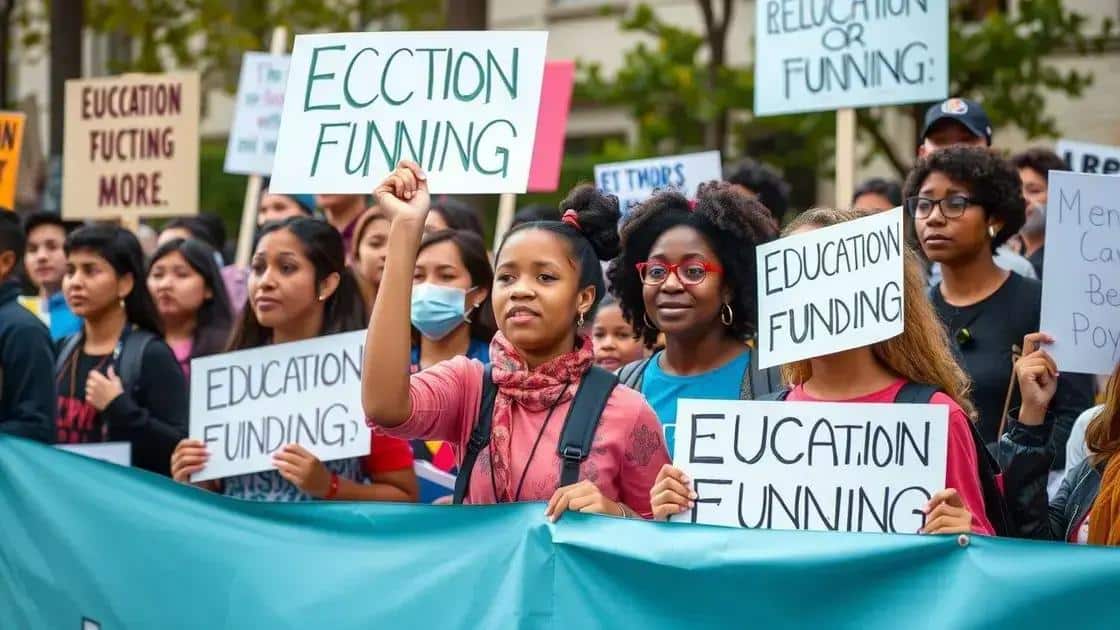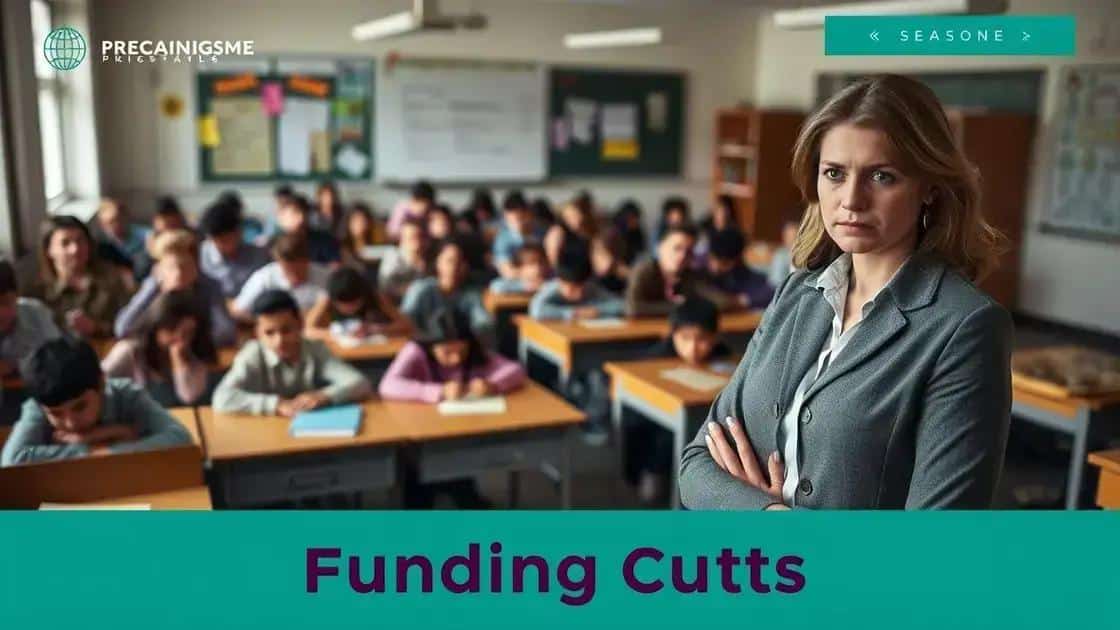Protests against education budget cuts spark passionate debate

Protests against education budget cuts have united communities to advocate for better funding through organized events, strategic communication, and collaborative efforts involving students, parents, educators, and local leaders.
Protests against education budget cuts have become a rallying cry across the nation, igniting discussions on the future of our schools. Ever wondered how these budget decisions affect our children’s education? Let’s dive into the conversation and discover the stakes involved.
The historical context of education budget cuts
Understanding the historical context of education budget cuts offers insight into why funding has become such a contentious issue today. Budget cuts in education have roots that go back decades, influenced by various political, economic, and social factors. They often emerge during times of economic downturn when governments reassess their financial priorities.
Since the 1980s, many states have struggled to balance their budgets, leading to a shift in funding away from public education. This has resulted in significant financial challenges for schools, jeopardizing educational programs and resources available to students.
Key Factors Contributing to Budget Cuts
Several critical factors contribute to these ongoing challenges:
- Economic Recession: Periods of economic decline cause tight budgets and reduced state revenues.
- Policy Changes: Shifts in government policies often redirect funding away from education.
- Population Changes: Changes in demographics can lead to fluctuations in funding needs.
- Competing Interests: Education funding often competes with other government priorities like healthcare and infrastructure.
The effects of these cuts extend beyond just financial implications. They affect not only the quality of education provided but also the morale of teachers and students. Schools left underfunded struggle to maintain essential programs, which can lead to larger classroom sizes and a lack of resources.
In recent years, communities have responded vigorously to these challenges, advocating for better funding mechanisms and greater accountability in spending. Grassroots movements have emerged, bringing together parents, teachers, and students to demand that education is prioritized in budget decisions.
The Role of Advocacy
Advocacy plays a significant role in countering budget cuts. Through organized efforts, stakeholders illustrate how vital education is to the future of society. Many communities hold workshops and forums to raise awareness about the impact of funding decisions on local schools and students.
As more people engage in the conversation about education funding, they build a movement that seeks to restore equity in education. By understanding the historical context of these budget cuts, advocates can better articulate their concerns and push for meaningful reform.
Impact of funding cuts on students and teachers

The impact of funding cuts on students and teachers is profound and multifaceted. These cuts affect everything from classroom resources to teacher morale, creating a ripple effect that influences the quality of education. When funding is reduced, it often leads to overcrowded classrooms and outdated materials that can hinder student learning.
Teachers face more challenges as they strive to provide a quality education with limited resources. Their workloads increase, often requiring them to purchase supplies out of their own pockets. This can lead to frustration and burnout, impacting their ability to inspire and engage students effectively.
Consequences for Students
Students bear the brunt of funding cuts in very tangible ways:
- Reduced Resources: Libraries and technology become less accessible, limiting students’ research and learning opportunities.
- Increased Class Sizes: More students in a classroom mean less individual attention from teachers, which can affect learning outcomes.
- Extra-Curricular Activities: Many sports and arts programs face elimination, depriving students of vital opportunities for personal growth.
- Deteriorating Facilities: Schools may struggle to maintain safe and adequate facilities, impacting the overall learning environment.
These issues create an environment where students may feel disengaged or unsupported. The lack of adequate funding can lead to decreased motivation and lower academic performance.
Effects on Teaching Quality
The quality of teaching suffers significantly when teachers lack essential support. Teachers often report feeling undervalued and overworked, which can lead to high turnover rates. When experienced teachers leave, it disrupts the continuity of education for students and can result in less effective teaching practices.
Moreover, new teachers may face steep learning curves without the mentorship and guidance that experienced teachers can provide. This can lead to inconsistencies in educational quality across different classrooms and schools, further widening the achievement gap among students.
Ultimately, the implications of funding cuts extend far beyond the classroom. They affect the community as a whole, as education is foundational for creating informed and engaged citizens. Understanding and addressing these impacts is essential for advocating for better education funding.
Community responses to education funding challenges
Community responses to education funding challenges illustrate how collective action can drive change. As funding cuts have affected schools, communities have come together in numerous ways to address these critical issues. Grassroots movements are emerging as parents, teachers, and students unite to advocate for better funding.
One common response has been organizing protests. These events not only raise awareness but also show policymakers that education is a community priority. Schools with strong community support often see better turnout for events, highlighting the collective desire for change.
Building Coalitions
Many communities create coalitions aimed at tackling education funding. These groups often consist of:
- Parents and Guardians: They play a key role in advocating for their children’s education.
- Local Organizations: Nonprofits and civic groups often lend their support and resources.
- Teachers and Educators: They provide insights into the real impacts of funding cuts.
- Students: Their voices are crucial in highlighting the effects of budget decisions on their learning experiences.
By collaborating, these coalitions can amplify their impact, making it harder for decision-makers to ignore their needs. Sharing stories and experiences can build a stronger emotional appeal, driving home the significance of adequate funding.
Creative Fundraising Efforts
In addition to advocacy, communities often turn to creative fundraising efforts to support schools. These initiatives can include:
- Fundraising Events: Organizing community events such as bake sales, fun runs, or auctions.
- Partnerships with Local Businesses: Collaborating with businesses for sponsorships or donations.
- Grant Applications: Seeking grants from state and federal sources focused on education improvement.
- Crowdfunding Campaigns: Using online platforms to raise money for specific projects or resources.
These efforts can supplement funding shortfalls and provide immediate relief to struggling schools, helping to maintain essential programs and services.
Moreover, building awareness about the consequences of funding cuts is vital. Through social media campaigns and community forums, stakeholders can share important information and mobilize more individuals, creating a larger support network.
Ultimately, community responses to education funding challenges showcase the power of collective action. These actions not only help address immediate needs but also lay the groundwork for systemic change in how education is funded.
Strategies for advocating better education funding

Implementing effective strategies for advocating better education funding is crucial for community members who want to influence decision-makers. Various approaches can be utilized to raise awareness and push for changes in funding policies. By engaging the community and increasing visibility, advocates can effectively present the case for increased support in education.
One solid strategy is to organize informational meetings. These gatherings can be a platform for sharing facts about the impact of funding cuts, allowing community members to learn and engage with the issue. Connecting with local educators and parents to amplify their voices is essential in these discussions.
Building Community Support
Building broad community support throughout the advocacy process is important. A few effective ways to do this include:
- Hosting Workshops: Provide workshops that educate the community on the budget process and how they can get involved.
- Utilizing Social Media: Create online campaigns to reach a wider audience and gather support.
- Engaging Local Leaders: Collaborate with community leaders to champion education funding initiatives.
- Collecting Petitions: Gather signatures from students, parents, and community members to show widespread support.
Community engagement can create a sense of urgency around the need for change. When people see that others care deeply about education funding, they are more likely to get involved.
Effective Communication Techniques
Another significant part of advocacy lies in communication. Crafting clear and impactful messages can help convey the importance of the cause. Key techniques include:
- Telling Personal Stories: Share relatable experiences that illustrate the challenges faced due to funding cuts.
- Statistics and Data: Use compelling data to highlight the issue’s severity and urgency.
- Visual Aids: Create posters or infographics that show the impact of funding cuts visually.
- Regular Updates: Keep the community informed about ongoing efforts and successes.
By sharing stories and statistics, advocates can evoke empathy and motivate others to take action. Engaging visuals can further capture attention and drive points home effectively.
All these strategies encourage collaboration and community involvement in advocating for better education funding. They can unite the community, amplify the call for change, and influence policymakers to prioritize education in budgets.
FAQ – Frequently Asked Questions about Education Funding Advocacy
Why is community involvement important in education funding advocacy?
Community involvement amplifies voices, creates a support network, and shows policymakers that education is a priority for everyone.
What are effective ways to raise awareness about education funding cuts?
Hosting meetings, using social media, and sharing personal stories are effective ways to raise awareness and encourage community action.
How can I get my local leaders involved in education funding advocacy?
You can engage local leaders by inviting them to community meetings, presenting them with data, and highlighting the local impact of funding issues.
What steps can I take to get started on advocating for better education funding?
Start by educating yourself on funding issues, building a community coalition, organizing events, and communicating effectively with stakeholders.





